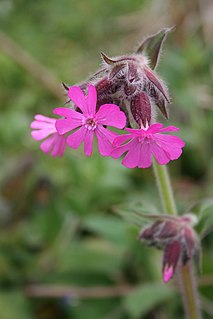
Silene is a genus of flowering plants in the family Caryophyllaceae. Containing nearly 900 species, it is the largest genus in the family. Common names include campion and catchfly. Many Silene species are widely distributed, particularly in the northern hemisphere.

Caryophyllaceae, commonly called the pink family or carnation family, is a family of flowering plants. It is included in the dicotyledon order Caryophyllales in the APG III system, alongside 33 other families, including Amaranthaceae, Cactaceae, and Polygonaceae. It is a large family, with 81 genera and about 2,625 known species.
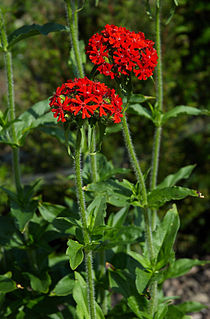
Silene chalcedonica, the Maltese-cross or scarlet lychnis, is a species of flowering plant in the family Caryophyllaceae, native to central and eastern Russia, Kazakhstan, Mongolia and northwestern China. Other common names include flower of Bristol, Jerusalem cross and nonesuch.

Silene virginica, the fire pink, is a wildflower in the pink family, Caryophyllaceae. It is known for its distinct brilliant red flowers. Each flower is approximately five centimeters in diameter and composed of five notched, brilliant red petals which extend into a long tube. It is a small, short-lived perennial, with lance shaped leaves. Its stems, and the bases of the flowers, are covered in short sticky hairs. Fire pink begins blooming in late spring and continuing throughout the summer. It is sometimes grown in wildflower, shade, and rock gardens.

Silene acaulis, known as moss campion or cushion pink, is a small mountain-dwelling wildflower that is common all over the high arctic and tundra in the higher mountains of Eurasia and North America,. It is an evergreen perennial flowering plant in the carnation family Caryophyllaceae.
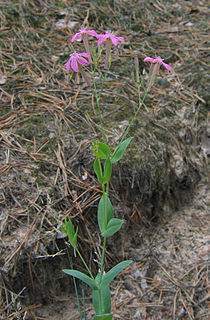
Silene armeria, commonly known as the Sweet William catchfly, is a species of plant in the family Caryophyllaceae. Originally a native of Europe, it has become widespread in the United States. Perennial in USDA plant hardiness zones 5 to 8. A small-growing form is known as dwarf catchfly. The name comes from the way in which small insects are trapped by the sticky sap exuded onto the stem. However it is not currently regarded as a carnivorous plant, though it has been identified as a carnivorous plant in the past.

Silene dioica, known as red campion and red catchfly, is a herbaceous flowering plant in the family Caryophyllaceae, native throughout central, western and northern Europe, and locally in southern Europe. It has been introduced in Iceland, Canada, the US, and Argentina.

Silene nutans is a flowering plant in the genus Silene, most commonly known as Nottingham catchfly.
Silene salmonacea is a rare, newly described species of flowering plant in the family Caryophyllaceae known by the common names Klamath Mountain catchfly and salmon-flowered catchfly. It is known only from Trinity County, California, where it grows in the forests of the southern Klamath Mountains. It is a member of the serpentine soils flora. It is a small perennial herb growing just a few centimeters tall. The spoon-shaped leaves are up to 3.5 centimeters long. The herbage is gray-green and lightly woolly in texture. Each flower has a tubular calyx of fused sepals lined with ten veins. There are five salmon pink petals, each with four lobes at the tip.
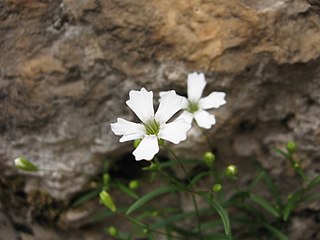
Heliosperma is a genus of flowering plants in the family Caryophyllaceae. As such, it is closely related to the large genus Silene, but its members can be told apart from Silene by the crest of long papillae on the seeds. The majority of the species are narrow endemics from the Balkan Peninsula, but H. alpestre is endemic to the Eastern Alps, and H. pusillum is found from the Cordillera Cantábrica in northern Spain to the Carpathians. Like members of the genus Silene and other related genera, Heliosperma is attacked by species of the anther smut fungus Microbotryum. Cases of parallel divergence events between alpine and mountain populations have been reported in this genus.

Silene uniflora is a species of flowering plant in the family Caryophyllaceae known by the common name sea campion.

Silene conica is a species of flowering plant in the family Caryophyllaceae known by the common names striped corn catchfly and sand catchfly. It grows in dunes and sandy soils and is widespread in Europe and western Asia. It has an annual life history and produces self-compatible hermaphroditic flowers and occasional male-sterile flowers. Like other members of Silene section Conoimorpha, S. conica is readily recognizable based on its bright pink petals and the prominent, parallel veins on its calyx. In contrast to most flowering plants, S. conica appears to have a very rapid rate of mitochondrial mutation, and has the largest mitochondrial genome ever identified.
Silene jenisseensis, is a species of flowering plant in the family Caryophyllaceae, native to Siberia, Far East and Mongolia.
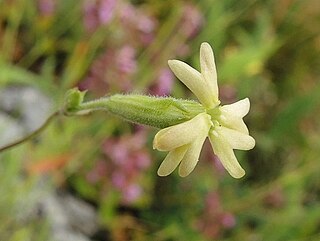
Silene flavescens are flowering plants part of the genus Silene, family Caryophyllaceae. They are widely distributed and are found in the northern hemisphere. They are native to Hungary and the Balkan Peninsula. It is an herbaceous species belonging to the tribe Sileneae

Silene otites, called Spanish catchfly, is a species of flowering plant in the genus Silene, native to Europe and the Transcaucasus area, and introduced to Xinjiang in China. It varies its floral odors to attract mosquitoes and moths at night and flies and bees by day. It is dioecious, with separate male and female plants.
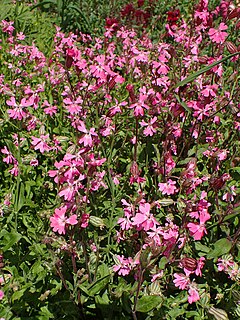
Silene pendula, called the nodding catchfly or drooping catchfly, is a species of flowering plant in the genus Silene, native to Italy, Greece, and Turkey, and introduced to scattered locations in North America, South America, Africa, Europe and Asia. A number of cultivars are available. A 2020 study showed with certainty that, despite their morphological similarities, Silene cisplatensis is not synonymous with Silene pendula.
Silene tibetica is a species of plant which is a member of the family Caryophyllaceae. The species can be found in Tibet.

Silene banksia is a species of flowering plant in the family Caryophyllaceae. It is native to southeastern Siberia, most of China, and North Korea, and it has been introduced to Mongolia and Japan. The species goes by the common names Chinese lychnis and jian chun luo. It is a cultigen, domesticated in northeast Asia at some time on the distant past. No wild individuals are known.

Silene tamaranae is a species of plant in the Caryophyllaceae family.

Silene sedoides is a species of Silene. It is widely distributed across the Aegean Sea but one of its subspecies is endemic to Greece.
















